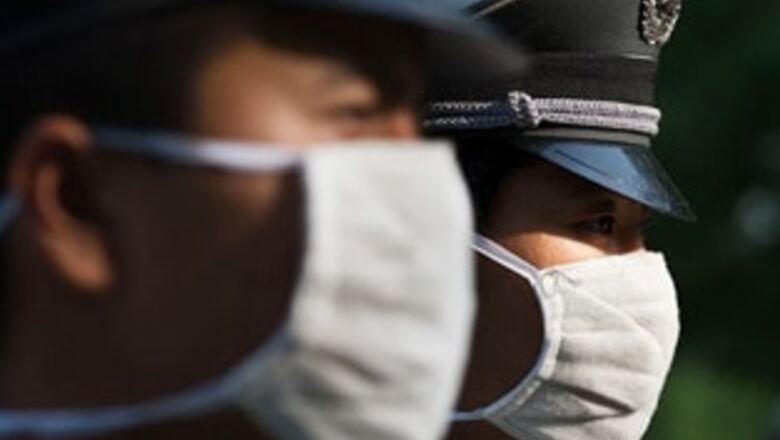
views
Geneva: The World Health Organization said on Thursday that up to 2 billion people could be infected by swine flu if the current outbreak turns into a pandemic. The agency said a pandemic typically lasts two years.
WHO flu chief Keiji Fukuda said the number wasn't a prediction, but that experience with flu pandemics showed one-third of the world's population gets infected.
"If we do move into a pandemic then our expectation is that we will see a large number of people infected worldwide," Fukuda said. "If you look at past pandemics, it would be a reasonable estimate to say perhaps a third of the world's population would get infected with this virus."
In Mexico, which has had the most cases, high schools and universities opened for the first time in two weeks as the country's top health official insisted the epidemic is on the decline. All students were checked for swine flu symptoms and some were sent home.
Fukuda said WHO is unable to know what the future holds and that it is impossible now to say whether the outbreak will turn into a pandemic or whether it would be a mild or severe strain of influenza.
Even with a mild flu, "from the global perspective there are still very large numbers of people who could develop pneumonia, require respirators, who could die," Fukuda said.
People react differently to the flu depending on their general state of health and other factors.
Some younger people in the Southern Hemisphere may be more vulnerable because of malnourishment, war, HIV infections and other factors, Fukuda said. This means a mild outbreak in wealthier countries can be "quite severe in its impact in the developing world," he said.
"We expect this kind of event to unfold over weeks and months. Pandemics don't occur in a couple of days. When we go back and we look at history, we're often looking at a one-year period. Really if you look over a two-period that is really the period in which you see an increase in the number of illnesses and deaths during a pandemic influenza."
PAGE_BREAK
History has been the spur to WHO to make sure the world is as prepared as possible for a pandemic, which would be recognized by a rise to phase 6 from the current phase 5 in the agency's alert scale. That would mean general spread of the disease in another region beyond North America, where the outbreak so far has been heaviest.
"I'm not quite sure we know if we're going to phase 6 or not, or when we would do so," Fukuda said. "It's really impossible for anybody to predict right now."
Mexican dance halls, movie theatres and bars were allowed to fully reopen Thursday after a five-day shutdown designed to curb the virus' spread. Businesses must screen for any sick customers and restaurant employees must wear surgical masks.
Fans can attend professional soccer matches this weekend after all were played in empty stadiums last weekend.
Mexico confirmed two more deaths, for a total of 44, while 1,160 people have been sickened, up 90 from Wednesday. Despite death tolls and confirmed caseloads that rise daily, Health Secretary Jose Angel Cordova insisted the epidemic is waning in Mexico.
The WHO said the number of confirmed swine flu cases around the world has surpassed 2,000.
This swine flu seems to have a long incubation period — five to seven days before people notice symptoms, according to Dr. Marc-Alain Widdowson, a medical epidemiologist from the U.S. Centers for Disease Control and Prevention now tracking the flu in Mexico City. That means the virus can keep being spread by people who won't know to stay home.
Mexico had mobilized teachers and parents to disinfect its schools before reopening. Primary schools reopen next week.
Laughing and joking, high school students gathered at the entrance of the National School of Graphic Arts in Mexico City, waiting to fill out forms that asked about their health.
Of 280 students entering the school in the first 20 minutes, two showed symptoms of swine flu, including coughing and nasal congestion, said assistant principal Ana Maria Calvo Vega. Their parents were notified and they won't be readmitted without a statement from a doctor saying they don't have the virus, she said.
PAGE_BREAK
Students at a Mexico City vocational high school were welcomed with a dollop of hand sanitizer and a surgical mask. Joyful to see each other again, students embraced and kissed — some through masks.
Parents expressed relief that their children, shuttered so long at home, could return to class. But they also worried that the virus could surge back once 40 million young people gather in groups again.
"My 17-year-old daughter is afraid. She knows she must go back but doesn't want to," said Silvia Mendez as she walked with her 4-year-old son, Enrique, in San Miguel Topilejo, a town perched in forested mountains near the capital.
Working parents have struggled to provide child care during the shutdown. It forced many to stay home from work, bring their youngsters to their jobs, or leave them at home.
Each school, Mexican officials said, had to be cleaned and inspected this week. Complicating the task: Many schools are primitive buildings with dirt floors and lack proper bathrooms. It was unclear how students attending those schools could adhere to the government's strict sanitary conditions.
The government promised detergent, chlorine, trash bags, anti-bacterial soap or antiseptic gel and face masks to state governments for delivery to public schools. But some local districts apparently didn't get the word.
U.S. health officials are no longer recommending that schools close because of suspected swine flu cases since the virus has turned out to be milder than initially feared. But many U.S. schools have done so anyway, including the school of a Texas teacher who died.



















Comments
0 comment